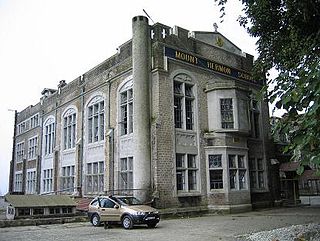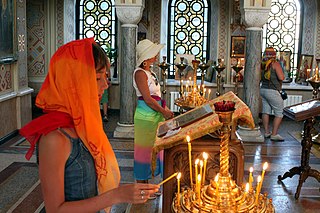Related Research Articles

Cyril of Jerusalem was a theologian of the early Church. About the end of 350 AD he succeeded Maximus as Bishop of Jerusalem, but was exiled on more than one occasion due to the enmity of Acacius of Caesarea, and the policies of various emperors. Cyril left important writings documenting the instruction of catechumens and the order of the Liturgy in his day.

Justinian II, surnamed Rhinotmetos or Rhinotmetus, was the last Byzantine emperor of the Heraclian dynasty, reigning from 685 to 695 and again from 705 to 711. Like Justinian I, Justinian II was an ambitious and passionate ruler who was keen to restore the Roman Empire to its former glories, but he responded brutally to any opposition to his will and lacked the finesse of his father, Constantine IV. Consequently, he generated enormous opposition to his reign, resulting in his deposition in 695 in a popular uprising, and he only returned to the throne in 705 with the help of a Bulgar and Slav army. His second reign was even more despotic than the first, and it too saw his eventual overthrow in 711, abandoned by his army who turned on him before killing him.

Mount Hermon is a mountain cluster constituting the southern end of the Anti-Lebanon mountain range. Its summit straddles the border between Syria and Lebanon and, at 2,814 m (9,232 ft) above sea level, is the highest point in Syria. On the top, in the United Nations buffer zone between Syrian and Israeli-occupied territories, is the highest permanently manned UN position in the world, known as "Hermon Hotel", located at 2814 metres altitude. The southern slopes of Mount Hermon extend to the Israeli-occupied portion of the Golan Heights, where the Mount Hermon ski resort is located with a top elevation of 2,040 metres. A peak in this area rising to 2,236 m (7,336 ft) is the highest elevation in Israeli-controlled territory.

The Episcopal Church of Jerusalem and the Middle East is a province of the Anglican Communion. The primate of the church is called President Bishop and represents the Church at the international Anglican Communion Primates' Meetings. The Central Synod of the church is its deliberative and legislative organ.

A mystagogue is a person who initiates others into mystic beliefs, and an educator or person who has knowledge of the sacred mysteries of a belief system. Another word for mystagogue is hierophant.

The Christianization of Kievan Rus' took place in several stages. In early 867, Patriarch Photius of Constantinople announced to other Christian patriarchs that the Rus', baptized by his bishop, took to Christianity with particular enthusiasm. Photius's attempts at Christianizing the country seem to have entailed no lasting consequences, since the Primary Chronicle and other Slavonic sources describe the tenth-century Rus' as firmly entrenched in paganism. Following the Primary Chronicle, the definitive Christianization of Kievan Rus' dates from the year 988, when Vladimir the Great was baptized in Chersonesus and proceeded to baptize his family and people in Kiev. The latter events are traditionally referred to as baptism of Rus' in Ukrainian and Russian literature.

Macarius I ; was Bishop of Jerusalem from 312 to shortly before 335, according to Sozomen. He is recognized as a saint within the Orthodox and Catholic churches.

Chersonesus, in medieval Greek contracted to Cherson is an ancient Greek colony founded approximately 2,500 years ago in the southwestern part of the Crimean Peninsula. Settlers from Heraclea Pontica in Bithynia established the colony in the 6th century BC.

Sudak is a town, multiple former Eastern Orthodox bishopric and double Latin Catholic titular see. It is of regional significance in Crimea, a territory recognized by most countries as part of Ukraine but annexed by Russia as the Republic of Crimea. Sudak serves as the administrative center of Sudak Municipality, one of the regions Crimea is divided into. It is situated 57 km (35 mi) to the west of Feodosia and 104 km (65 mi) to the east of Simferopol, the republic's capital. Population: 16,492 .
The Aetherius Society is a new religious movement founded by George King in the mid-1950s as the result of what King claimed were contacts with extraterrestrial intelligences, to whom he referred as "Cosmic Masters". The main goal of the believer is to cooperate with these Cosmic Masters to help humanity solve its current Earthly problems and advance into the New Age.

Mount Hermon School is a co-educational Christian boarding school in the town of Darjeeling, in the Indian state of West Bengal. It is located in North Point, Singmari. It follows the American education style, rather than the British style in vogue in the other schools of the area. It prepares children for ICSE and ISC. Mount Hermon offers classes in science, humanities, and commerce. More than 25 languages are spoken among the student body.

Caesarea Philippi was an ancient Roman city located at the southwestern base of Mount Hermon. It was adjacent to a spring, grotto, and related shrines dedicated to the Greek god Pan. Now nearly uninhabited, Caesarea is an archaeological site in the Golan Heights.

Jerusalem's role in first-century Christianity, during the ministry of Jesus and the Apostolic Age, as recorded in the New Testament, gives it great importance.
Theodora of Khazaria was Byzantine empress as the second wife of Justinian II. She was a sister of Busir, khagan of the Khazars, but their relation to other Khazar rulers such as Bihar, father of the future Empress Tzitzak, is unknown.
Early Christianity spread from the Eastern Mediterranean throughout the Roman Empire and beyond. Originally, this progression was closely connected to already established Jewish centers in the Holy Land and the Jewish diaspora. The first followers of Christianity were Jews or proselytes, commonly referred to as Jewish Christians and God-fearers.

The Theme of Cherson, originally and formally called the Klimata was a Byzantine theme located in the southern Crimea, headquartered at Cherson.
In Christianity, Church councils are formal meetings of bishops and representatives of several churches who are brought together to regulate points of doctrine or discipline. The meetings may be of a single ecclesiastical community or may involve an ecclesiastical province, a nation or other civil region, or the whole Church. Some of those convoked from the Church as a whole have been recognized as ecumenical councils and are considered particularly authoritative. The first ecumenical council is that of Nicaea, called by the Emperor Constantine in 325.

The Temples of Mount Hermon are around thirty Roman shrines and Roman temples that are dispersed around the slopes of Mount Hermon in Lebanon, Israel and Syria. A few temples are built on former buildings of the Phoenician & Hellenistic era, but nearly all are considered to be of Roman construction and were largely abandoned during the persecution of pagans in the late Roman Empire.

The majority of the Crimean population adheres to the Russian Orthodox Church, with the Crimean Tatars forming a Sunni Muslim minority, besides smaller Roman Catholic, Ukrainian Greek Catholic, Armenian Apostolic and Jewish minorities.
The Hieromartyrs of Cherson were a group of early 4th-century bishops who were martyred in Cherson, at the time in the Bosporan Kingdom in Taurica (Crimea) under the Roman client king Tiberius Julius Rhadamsades, during the Diocletian persecution (303–313). They are commemorated on March 7.